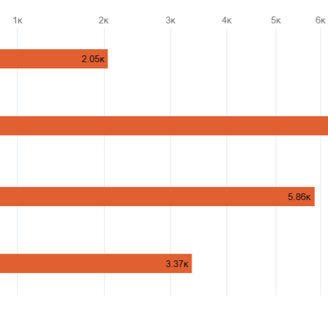Tendulkar vs Kohli - An unquantifiable (unpopular) debate
5/12/20257 min read
The table shown below must act as the introduction of this blog - the sheer numbers of Sachin Tendulkar and Virat Kohli.
Data source for all the tables in this article is Cricinfo and the visualizations have been created through Salesforce Tableau ( Einstein Analytics) Dashboards. Images if cannot be viewed completely, have to be clicked on to generate the full screen view

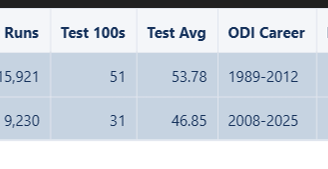
Overall Career
The careers of both the greats overlapped for a while, in both tests and one day internationals. While Sachin Tendulkar predominantly opened in one dayers, he also batted in the middle order occasionally - incidentally he batted at number 5 on his debut and was out for a duck. Virat Kohli batted mostly at numbers 3 and 4 in ODIs. Sachin continued to bat at number 4 in tests while Kohli batted at 3 or 5 as needed. Post Sachin's retirement, Virat continued to bat at number 3 in ODIs while he settled at the number 4 position in tests.
Sachin, based on the numbers and stats definitely seems to be superior in test cricket whereas the numbers are closer in limited overs cricket. Virat even has more centuries - these have come at a better innings/century rate than Sachin and the average is considerably higher too.
Records in SENA Countries ( Test matches)
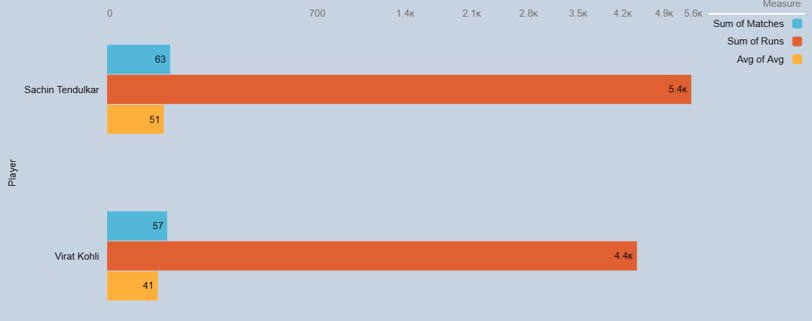

The number of matches played by both the legends being comparable, Sachin has the overall edge again in tests. A more insightful comparison emerges if we segregate the SENA ( South Africa, England, New Zealand and Australia) records into two different categories based on playing conditions - in England & New Zealand where the ball swings more than the other 2 countries - and in Australia & South Africa where pitches tend to be bouncy.
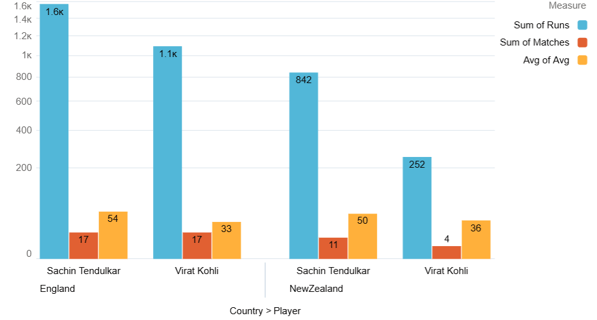

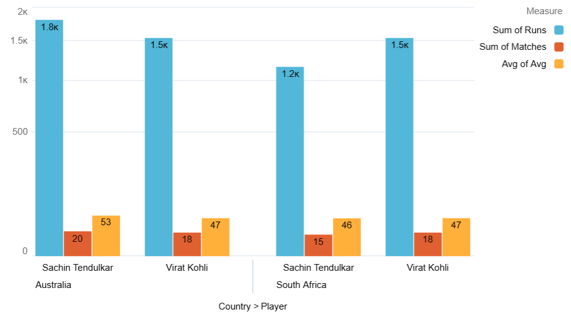

These numbers don't reveal much apart from the fact that Kohli has had a lot of misery in England. It is worth noting that English conditions tend to change during the course of a single day and the movement and swing are slightly difficult to negotiate. Kohli showed the propensity to nick outside the off stump and had visible struggles against James Anderson when India toured England in 2014 ( his series average was 13.40) but the fighter and the champion in him unfolded in 2018 when he led the batting chart for the series and amassed 593 runs in 5 tests at an average of 59.30 which again dipped in 2021.
Now, the trickiest question to be answered is " Who was better? ". A vast majority who saw Sachin bat would say it was him and the numbers prove so too. But is it fair to compare players from two generations? A few factors need to be considered before drawing conclusions.
Quality of the Opposition bowling
Rules and playing conditions
Team strengths and the respective batting line ups
Captaincy and its impact
Centuries scored under pressure
Off the field dynamics and relationships with the cricket board/support staff
Handling public backlash
Fitness and Injuries
Apart from a few such as the centuries scored, the others cannot be quantified. On the whole it would be a fair statement that Sachin and Virat played under similar conditions and countries - probably Sachin faced some of the tougher opponents at their peaks while Virat when confronted showed the world what he was capable of. The quality of opposition is a debatable topic as every generation had a previous generation of bowlers who were considered better.
Rules were similar in tests but Virat had the advantage of DRS and Sachin would most definitely rue those innumerable umpiring decisions that went against him. Virat was also part of two World Test Championship cycles in which every test match was virtually significant with additional pressure unlike the many dead rubbers earlier which otherwise attracted no attention.
Another key factor is the batting strengths of the respective teams they played for - this is a combination of talent, form and most importantly the collective number of runs scored. A deeper look at Sachin's career tells us that his batting average was the highest when he played under Sourav Ganguly's captaincy from 2000-2005. That particular side had probably India's most famous and iconic top order - Virender Sehwag, Rahul Dravid, Sachin himself, Sourav Ganguly and finally VVS Laxman. Arguably and statistically this line up was superior to what Virat's side had. Hence Sachin had some luxury and freedom while Virat had to carry almost the entire weight on his shoulders with help from Cheteshwar Pujara, Rohit Sharma and Ajinkya Rahane at various stages. Sachin must have done the same before 2000 but India were not considered great competitors abroad and the expectations were generally less when on tours.
When it comes to scoring centuries under pressure, it is a topic which could be discussed for hours and days together without drawing any conclusion but Sachin must have the edge here because of the sheer numbers and the longevity. He was the mainstay of Indian batting for more than two decades and India always set exorbitant expectations from him whenever he went to bat.
Virat was pugnacious and had his own way of being aggressive. He had disagreements with both the former coach Anil Kumble and the former BCCI president Sourav Ganguly. His fiery aggression symbolized the brand of cricket he wanted the team to play. Taunts from the hostile crowds only made him more determined. His captaincy was resolute, demanding and generally attacking and ruthless. The current crop of fast bowlers including Jasprit Bumrah, Mohammed Shami and Mohammed Siraj thrived and blossomed under Virat in tests. He was willing to get under the skin of his opponents and even the most prominent of Australian sledgers were careful and avoided conversations with Virat on the field - they realized that it would backfire.
On the other hand, Sachin was not someone who would openly get into arguments and rarely got involved in on field spats. Notably, he never made any statement openly about the former coach Greg Chappell whose eventful tenure coincided with Rahul Dravid being appointed the captain and India later crashing out of the 2007 ODI world cup in the group stage. Sachin mentions about the uncertainties and the insecurities of some of his then colleagues under Chappell in his autobiography. One gets a feeling that a player of his stature could have intervened earlier but off the field incidents such as this are best not discussed. Sachin's behavior is generally considered exemplary while playing cricket and he is a brand ambassador of the gentleman's game.
Virat remains India's most successful captain having won 40 out of the 68 tests he led and his relentlessly aggressive mindset was evident right from his first test as captain in Adelaide in 2015. He also took over the captaincy from MS Dhoni when India was struggling in tests and along with coach Ravi Shastri, forged a combination which was lethal and focused on winning overseas - which Dhoni clearly struggled with. And Virat's batting average as captain is way higher than while playing as non captain - part of it is because of the recent slump in form. Leading the national team is an honor but in a country like India, it can be tiresome, taxing and draining but Virat thrived under pressure and the additional responsibility only pushed him further. He doubtlessly wins the argument here.
Sachin was and still remains the most sought after cricketer in India. He is at the highest level of the upper echelons of Indian cricket. He also had the magnanimity to listen to a hotel waiter who advised him to remove or redesign his elbow guard during a particular period of struggle with the bat when he was not scoring as much as he would have liked to. While Virat has his share of fanbase, he also faces intense criticism whenever he fails to deliver. In the current age of social media, it may be imaginable about the backlash he would have received if he was stuck at the same score for close to 6 overs looking for a milestone against arch rivals Pakistan in a test match while strangely Rahul Dravid gets the blame for having declared when Sachin was at 194. In hindsight, Sachin must have been allowed to complete the double century but that is the game for us- we are always correct, only in hindsight.
Captaincy and batting records
Perhaps Sachin's only major injury concern was his battle with tennis elbow which sidelined him for a significant period when he was in form. Virat's fitness levels along with his dedication and work ethics are exemplary and second to none. Probably he is the fittest cricketer in the world now. And his sudden decision to retire caught many by surprise even as a variety of speculations emerge about the reasons behind the same. He did not even wait to cross the 10,000 run mark and considering that India is touring England next, his presence was vital especially when the team is in a transition phase following Rohit Sharma's retirement last week.
To conclude the article, it is next to impossible to compare cricketers across generation but we can only ponder about certain facts and factors and decide according to our discretion. The only definitive graph available to plot, specially when comparing giants who have played for long is the final numbers tally and Sachin is way ahead in that aspect considering his monumental achievements. Virat though, unfortunately bows out without a farewell test match.
Sachin and Virat have been pillars of Indian cricket and leave behind their own legacies. The next number 4 in Indian cricket certainly has a point to prove.

